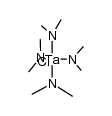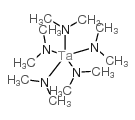(TERT-BUTYLIMINO)TRIS(DIMETHYLAMINO)TANTALUM
Modify Date: 2024-01-03 15:36:25

(TERT-BUTYLIMINO)TRIS(DIMETHYLAMINO)TANTALUM structure
|
Common Name | (TERT-BUTYLIMINO)TRIS(DIMETHYLAMINO)TANTALUM | ||
|---|---|---|---|---|
| CAS Number | 69039-11-8 | Molecular Weight | 384.29600 | |
| Density | N/A | Boiling Point | N/A | |
| Molecular Formula | C10H27N4Ta | Melting Point | N/A | |
| MSDS | N/A | Flash Point | N/A | |
| Name | tert-butyliminotantalum,dimethylazanide |
|---|---|
| Synonym | More Synonyms |
| Molecular Formula | C10H27N4Ta |
|---|---|
| Molecular Weight | 384.29600 |
| Exact Mass | 384.17200 |
| PSA | 22.08000 |
| LogP | 1.55470 |
|
Section 1: Product Identification t-Butylimidotris(dimethylamido)tantalum(V), min. 98%, 73-0700, contained in 50 ml Swagelok® cylinder Chemical Name: (96-1070) for CVD/ALD CAS Registry Number:69039-11-8 Formula:C10H27N4Ta EINECS Number:none
Chemical Family:metal amide complex Synonym:tris(Dimethylamino)-tert-butylamido tantalum Section 2: Composition and Information on Ingredients IngredientCAS NumberPercentACGIH (TWA)OSHA (PEL) Title compound69039-11-8100%5 mg/m3 (Ta)5 mg/m3 (Ta) Section 3: Hazards Identification Emergency Overview:Irritating to skin, eyes and respiratory tract. Primary Routes of Exposure:Contact with skin and eyes. Inhalation of dust. Eye Contact:A moderate irritant to the eyes causing redness and pain. Skin Contact:Causes moderate irritation of the skin causing redness, selling and itching. Inhalation of dust will lead to irritation of the respiratory tract, soreness of the nose and throat, coughing and Inhalation: sneezing. Ingestion:No information available on the physiological effects of ingestion. May be harmful if swallowed. Acute Health Affects:Irritating to skin, eyes and respiratory tract. Chronic Health Affects:No information on long-term chronic effects. NTP:No IARC:No OSHA:No SECTION 4: First Aid Measures Immediately flush the eyes with copious amounts of water for at least 10-15 minutes. A victim may need Eye Exposure: assistance in keeping their eye lids open. Get immediate medical attention. Wash the affected area with water. Remove contaminated clothes if necessary. Seek medical assistance if Skin Exposure: irritation persists. Remove the victim to fresh air. Closely monitor the victim for signs of respiratory problems, such as difficulty Inhalation: in breathing, coughing, wheezing, or pain. In such cases seek immediate medical assistance. Seek medical attention immediately. Keep the victim calm. Give the victim water (only if conscious). Induce Ingestion: vomiting only if directed by medical personnel. SECTION 5: Fire Fighting Measures Flash Point:no data Autoignition Temperature:none Explosion Limits:none Extinguishing Medium:carbon dioxide, foam or dry powder If this product is involved in a fire, fire fighters should be equipped with a NIOSH approved positive pressure Special Fire Fighting Procedures: self-contained breathing apparatus and full protective clothing. Hazardous Combustion andIf involved in a fire, this material may emit irritating organic fumes. Decomposion Products: Unusual Fire or Explosion Hazards: No unusual fire or explosion hazards. SECTION 6: Accidental Release Measures Small spills can be mixed with vermiculite, sodium carbonate or other suitable non-combustible adsorbent and Spill and Leak Procedures: swept up. SECTION 7: Handling and Storage Store in a tightly sealed container under an inert atmosphere of nitrogen or argon. Keep in a cool, dry, well Handling and Storage: ventilated place. SECTION 8: Exposure Controls and Personal Protection Eye Protection:Always wear approved safety glasses when handling a chemical substance in the laboratory. Skin Protection:Wear protective clothing and gloves. Ventilation:Handle the material in an efficient fume hood. If ventilation is not available a respirator should be worn. The use of respirators requires a Respirator Respirator: Protection Program to be in compliance with 29 CFR 1910.134. Ventilation:Handle the material in an efficient fume hood. Additional Protection:No additional protection required. SECTION 9: Physical and Chemical Properties Color and Form:colorless solid Molecular Weight:384.3 Melting Point:no data Boiling Point:no data Vapor Pressure:no data Specific Gravity:no data Odor:none Solubility in Water:insoluble SECTION 10: Stability and Reactivity Stability:air sensitive, moisture sensitive Hazardous Polymerization:no hazardous polymerization Conditions to Avoid:prolonged exposure to air and moisture Incompatibility:water, halogens, strong oxidizing agents Decomposition Products:carbon dioxide, carbon monoxide, organic fumes, nitrogen oxides and tantalum oxide. SECTION 11: Toxicological Information RTECS Data:No information available from the RTECS files. Carcinogenic Effects:no data Mutagenic Effects:no data Tetratogenic Effects:no data SECTION 12: Ecological Information Ecological Information:No information available. SECTION 13: Disposal Considerations Disposal:Dispose of this material according to local, state and federal regulations. SECTION 14: Transportation Shipping Name (CFR):Non-hazardous Hazard Class (CFR):NA Additional Hazard Class (CFR):NA Packaging Group (CFR):NA UN ID Number (CFR):NA Shipping Name (IATA):Non-hazardous Hazard Class (IATA):NA Additional Hazard Class (IATA):NA Packaging Group (IATA):NA UN ID Number (IATA):NA SECTION 15: Regulatory Information TSCA:Not listed in the TSCA inventory SARA (Title 313):Title compound not listed Second Ingredient:none SECTION 16 - ADDITIONAL INFORMATION N/A |
|
~37%
Detail
|
| Literature: Nugent, William A. Inorganic Chemistry, 1983 , vol. 22, p. 965 - 969 |
|
~% 
(TERT-BUTYLIMIN... CAS#:69039-11-8 |
| Literature: Nugent, William A. Inorganic Chemistry, 1983 , vol. 22, p. 965 - 969 |
| MFCD05863998 |





